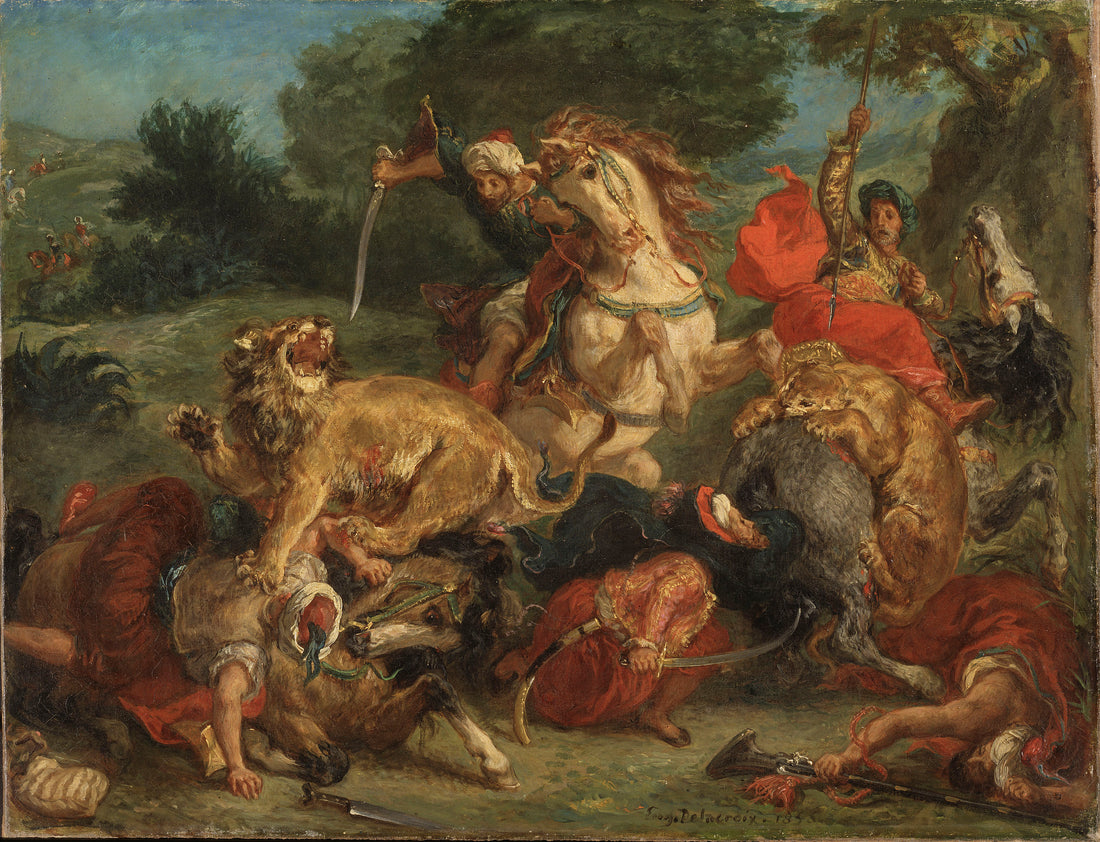
Delacroix’s Oriental Journey: Bridging Cultures through Art
Share
Eugene Delacroix: A Journey Through Orientalist Art
The Voyage of a Visionary
Eugene Delacroix (1798 - 1863), a luminary of the 19th century art world, is often hailed as a pioneer of the Romantic movement. His artistic endeavors were not confined to the studios of Paris; they extended into the heart of the Orient. Delacroix's journey to North Africa in 1832, particularly to Morocco, was more than a mere voyage – it was a foray into a world that would deeply influence his palette and perspective.

Portrait of Delacroix
Embarking on the Exotic
Delacroix's travel to the Orient, embarked upon at a time when such journeys were arduous, was fueled by an insatiable curiosity about cultures and vistas unknown to most Europeans of his time. This expedition followed the French invasion of Algeria, a period marked by both conflict and fascination with the Arab world. His journey took him to Morocco, then to Algiers and beyond, where he was enthralled by the vibrant colors, the play of light, and the peculiarities of daily life.

Encounters of the Enchanted Kind
In Morocco, Delacroix was captivated by the vivacity and color of the local scenes. He attended traditional Moroccan ceremonies, visited bustling markets, and observed the daily life of the people. These experiences are vividly encapsulated in his sketches and later paintings. The fluidity and dynamism in works like "Women of Algiers in their Apartment" and "Moroccan Chieftain Receiving Tribute" reflect not just a mastery of form and color, but a deep engagement with a culture vastly different from his own.

Impact on the Artistic Canvas
Delacroix’s Orientalist phase was more than an exploration of exotic themes; it was a redefinition of European art. He introduced a palette that was bolder and more luminous than the subdued tones prevalent in his time. The fluidity of his brushwork and his emphasis on light and shadowheralded a shift towards Impressionism. Moreover, his portrayal of the Orient was nuanced, oscillating between the romantic and the realistic, a far cry from the often stereotypical depictions of the era.
The Legacy of Delacroix's Orientalist Art
The impact of Delacroix’s journey on his art was profound. It ushered in a new visual vocabulary in European art, one that embraced the exotic and the unknown. His works inspired a generation of artists, from the Impressionists to the Post-Impressionists, and continue to captivate viewers with their vibrancy and depth.
"Women of Algiers in their Apartment": A Masterpiece's Legacy
One of Delacroix's most famous works, "Women of Algiers in their Apartment," is a vivid representation of his encounter with the Oriental world. Painted in 1834, this masterpiece captures the essence of Algerian harem life, showcasing Delacroix's fascination with color and light. The painting was sold for a significant sum, reflecting its value in the art market. Today, its worth is estimated to be exponentially higher, underlining the enduring appeal of Delacroix's work. This piece is not just a painting; it's a portal into a world that was once mysterious and inaccessible to many.
Controversy in Canvas: Delacroix's Orientalist Art
Despite his acclaim, Delacroix's work was not without controversy. His Orientalist art, while groundbreaking, has been critiqued for its portrayal of Eastern cultures. Some argue that his depictions, though nuanced, still catered to Western perceptions and exoticism of the Orient. This debate underscores the complex relationship between art and cultural representation, especially in historical contexts. Delacroix's work, therefore, serves as a focal point for discussions about the power dynamics in art and the responsibilities of artists in portraying cultures other than their own.
The Question of Accuracy: Fact or Fantasy?
A pivotal aspect of Delacroix's art, particularly his portrayal of the Orient, is the debate over its accuracy. Was Delacroix's depiction of scenes like "Women of Algiers in their Apartment" a true representation of life in the Orient, or a romanticized fantasy? Scholars argue that while Delacroix strove for authenticity, capturing genuine details from his observations, his work inevitably filtered these through a European lens. This fusion of fact and fantasy created a portrayal that was both truthful in detail and imaginative in interpretation, offering a glimpse into the Orient as seen through the eyes of a Western artist. This blend of reality and romanticism continues to intrigue and challenge viewers, encouraging a deeper exploration of the complex narratives woven into Delacroix's Orientalist masterpieces. Women in Algiers sit in private areas and cover themselves when a stranger walks in. A source mentioned that Delacroix asked a local if it’s okay to see the harem area, the man agreed, but there were no women there. 
Delacroix’s Orientalist art is not just about depicting distant lands; it represents the profound influence of cultural immersion in artistic expression. His travels, marked by both discovery and challenges, highlight how the blending of diverse worlds can lead to the creation of exceptional art. In our ever-connected globe, Delacroix’s enduring legacy encourages us to explore new territories, to find inspiration in the unknown, and to imagine a world of boundless artistic possibilities.





